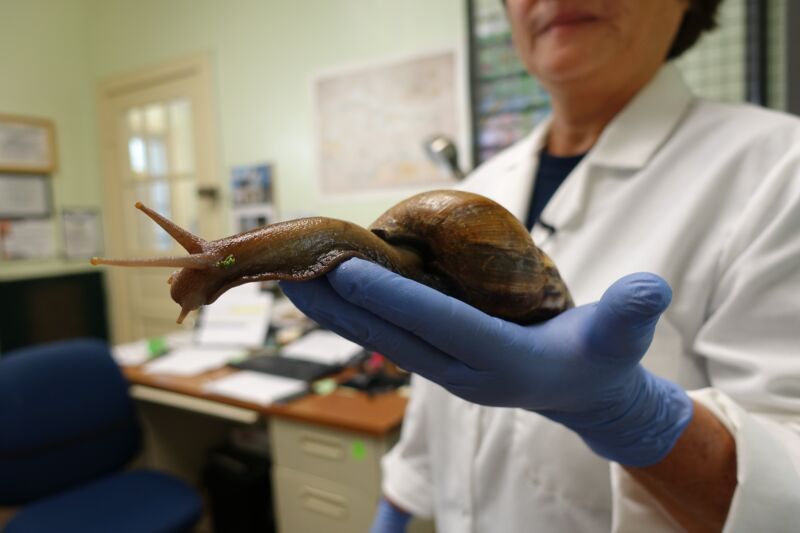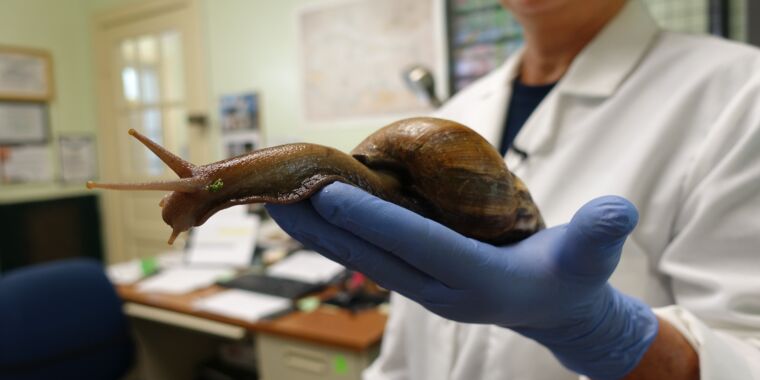
Officials in Florida are again battling a highly invasive, extraordinarily destructive giant snail species that also happens to be capable of spreading parasitic worms that invade human brains.
The giant African land snail (GALS)—aka Lissachatina fulica—can grow up to 20 centimeters (8 inches) long and is considered “one of the most invasive pests on the planet,” according to the Florida Department of Agriculture and Consumer Services. It ravenously feasts on over 500 plant species—including many valuable fruits, vegetables, and ornamentals—while prolifically spawning, pushing out several thousand eggs in its multiyear life span.
In late June, Florida state officials confirmed the presence of GALS on a property in Pasco County, on the west-central coast of the state, just north of Tampa. They have since set up a quarantine zone around the property and began snail-killing pesticide treatments last week.
While the snails are a grave threat to agriculture and natural vegetation in the state, the invasive mollusks also pose a health risk. They’re known to transmit rat lungworm parasites, which can invade the human central nervous system and cause a type of meningitis. For this reason, officials warn people not to handle the mammoth snails without gloves.
Brain invasion
You may recall that rat lungworm made headlines a few years ago when Hawaii’s health department tallied more than a dozen cases in 2018 and 2019. In 2018, the Centers for Disease Control and Prevention also published data on several unconnected cases from eight continental states between 2011 and 2017, suggesting a widespread presence.
The rat lungworm—aka Angiostrongylus cantonensis—gets its name by primarily infecting the lungs of rats and other rodents. In the lungs, adult worms mate and females lay eggs, which develop into larvae. The rats then cough up those young parasites and end up swallowing them, then pooping them out.
From those laden logs, the larvae infect snails and slugs (intermediate hosts), via burrowing into their soft bodies or in the event that the mollusks feast on infected feces. In the last steps of this gut-turning life cycle, rats nosh on the infected snails and slugs, delivering late-stage larvae that migrate from the rodent’s stomachs to their brains, where the worms develop into young adults. Those mature worms then migrate back to the rats’ lungs for breezy breeding time.
Humans are accidental hosts in this cycle. People pick up an infection by eating undercooked snails or slugs; eating fruits and vegetables contaminated by infected snails or slugs; or eating undercooked animals that may have eaten snails and slugs, such as frogs or crabs. Just like in rats, when the worms are ingested by humans, they make their way to the central nervous system.
Third eradication effort
But, in humans, they don’t generally make it out. They die in the CNS somewhere. Sometimes, this results in a symptomless infection—the worms die quietly and no treatment is needed. In other cases, the worms wriggle through the brain, wreaking havoc before kicking the bucket and causing a wide range of symptoms, including nausea, vomiting, neck stiffness, eye problems, abnormal sensations in the arms and legs, and headaches that are often global and severe, according to the CDC. Severe cases can lead to nerve damage, paralysis, coma, and death.
For all of the above reasons, officials in Florida are eager to stamp out these slimy scourges. But, it’s sadly not the first time Florida has battled the mollusks. Giant African land snails were declared eradicated from the state in 1975 and again in 2021. They were initially thought to be introduced to Flordia in the 1960s when a child brought three back from Hawaii as pets, which were eventually released into the wilds. It’s unclear how they were brought back more recently, but some believe they may have hitched rides on cargo or were brought into the state by religious groups for use in healing rituals.








